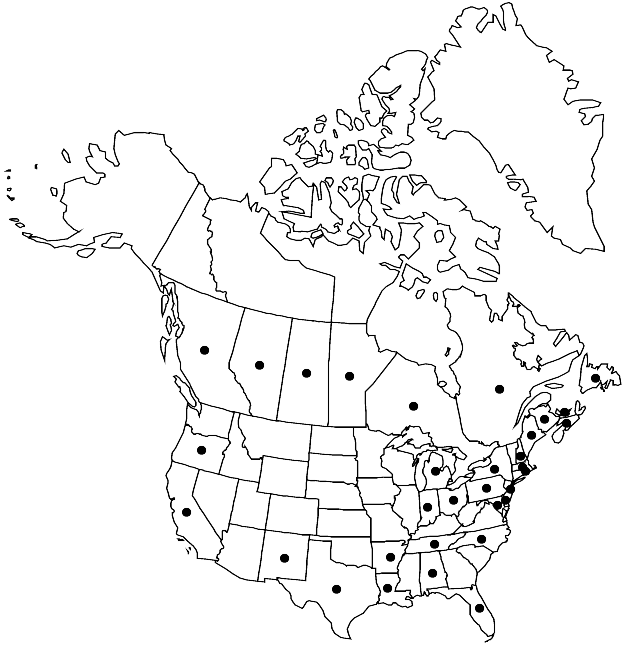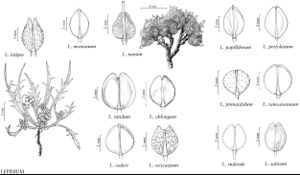Difference between revisions of "Lepidium ruderale"
Sp. Pl. 2: 645. 1753.
FNA>Volume Importer |
imported>Volume Importer |
||
| (One intermediate revision by the same user not shown) | |||
| Line 6: | Line 6: | ||
|place=2: 645. 1753 | |place=2: 645. 1753 | ||
|year=1753 | |year=1753 | ||
| + | }} | ||
| + | |special_status={{Treatment/ID/Special_status | ||
| + | |code=W | ||
| + | |label=Weedy | ||
| + | }}{{Treatment/ID/Special_status | ||
| + | |code=I | ||
| + | |label=Introduced | ||
| + | }}{{Treatment/ID/Special_status | ||
| + | |code=F | ||
| + | |label=Illustrated | ||
}} | }} | ||
|basionyms= | |basionyms= | ||
| Line 31: | Line 41: | ||
|elevation=0-300 m | |elevation=0-300 m | ||
|distribution=Alta.;B.C.;Man.;N.B.;Nfld. and Labr. (Nfld.);N.S.;Ont.;P.E.I.;Que.;Sask.;Ala.;Ark.;Calif.;Del.;Fla.;Ind.;La.;Maine;Md.;Mass.;Mich.;N.H.;N.J.;N.Mex.;N.Y.;N.C.;Ohio;Oreg.;Pa.;R.I.;Tenn.;Tex.;Eurasia;introduced also in South America;Australia. | |distribution=Alta.;B.C.;Man.;N.B.;Nfld. and Labr. (Nfld.);N.S.;Ont.;P.E.I.;Que.;Sask.;Ala.;Ark.;Calif.;Del.;Fla.;Ind.;La.;Maine;Md.;Mass.;Mich.;N.H.;N.J.;N.Mex.;N.Y.;N.C.;Ohio;Oreg.;Pa.;R.I.;Tenn.;Tex.;Eurasia;introduced also in South America;Australia. | ||
| + | |introduced=true | ||
|tables= | |tables= | ||
|references= | |references= | ||
| Line 53: | Line 64: | ||
|publication title=Sp. Pl. | |publication title=Sp. Pl. | ||
|publication year=1753 | |publication year=1753 | ||
| − | |special status= | + | |special status=Weedy;Introduced;Illustrated |
| − | |source xml=https:// | + | |source xml=https://bitbucket.org/aafc-mbb/fna-data-curation/src/2e0870ddd59836b60bcf96646a41e87ea5a5943a/coarse_grained_fna_xml/V7/V7_960.xml |
|tribe=Brassicaceae tribe Lepidieae | |tribe=Brassicaceae tribe Lepidieae | ||
|genus=Lepidium | |genus=Lepidium | ||
Latest revision as of 22:37, 5 November 2020
Annuals or biennials; (fetid); puberulent (trichomes cylindrical). Stems simple from base, erect ascending, branched (several) distally, (0.5–)1–3.5(–5.5) dm. Basal leaves rosulate; petiole 1–3.2(–5.3) cm; blade (1- or) 2- or 3-pinnatisect (lobes oblong), (1.5–)3–5(–7.2) cm, margins (of lobes) usually entire, rarely dentate. Cauline leaves sessile; blade linear, (0.4–)1–2(–3) cm × 0.5–2.5(–3.5) mm, base cuneate, not auriculate, margins entire. Racemes considerably elongated in fruit; rachis puberulent, trichomes straight, cylindrical. Fruiting pedicels divaricate to horizontal, straight, (terete), (1.5–)2–4(–5) × 0.1–0.15 mm, puberulent. Flowers: sepals oblong, 0.5–0.9(–1) × 0.2–0.4 mm; petals (absent or rudimentary), white, linear, 0.2–0.5 × 0.1 mm, claw absent; stamens 2, median; filaments 0.7–0.8 mm; anthers 0.1–0.2 mm. Fruits elliptic, (1.5–)1.8–2.5(–3) × 1.5–2(–2.3) mm, apically winged, apical notch 0.1–0.2 mm deep; valves thin, smooth, not veined, glabrous; style obsolete or to 0.1 mm, included in apical notch. Seeds oblong to ovate-oblong, 1–1.5 × 0.6–0.8 mm. 2n = 16, 32.
Phenology: Flowering Apr–Jul.
Habitat: Fields, pastures, waste places, roadsides, gardens
Elevation: 0-300 m
Distribution

Introduced; Alta., B.C., Man., N.B., Nfld. and Labr. (Nfld.), N.S., Ont., P.E.I., Que., Sask., Ala., Ark., Calif., Del., Fla., Ind., La., Maine, Md., Mass., Mich., N.H., N.J., N.Mex., N.Y., N.C., Ohio, Oreg., Pa., R.I., Tenn., Tex., Eurasia, introduced also in South America, Australia.
Discussion
Selected References
None.
